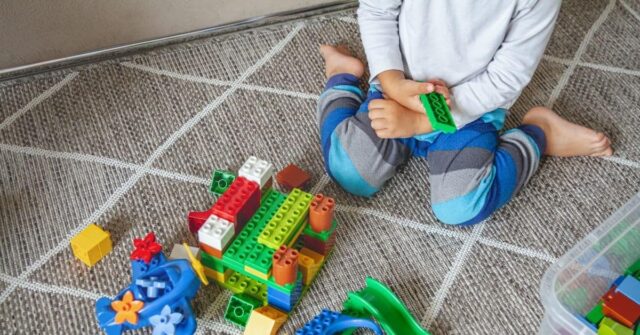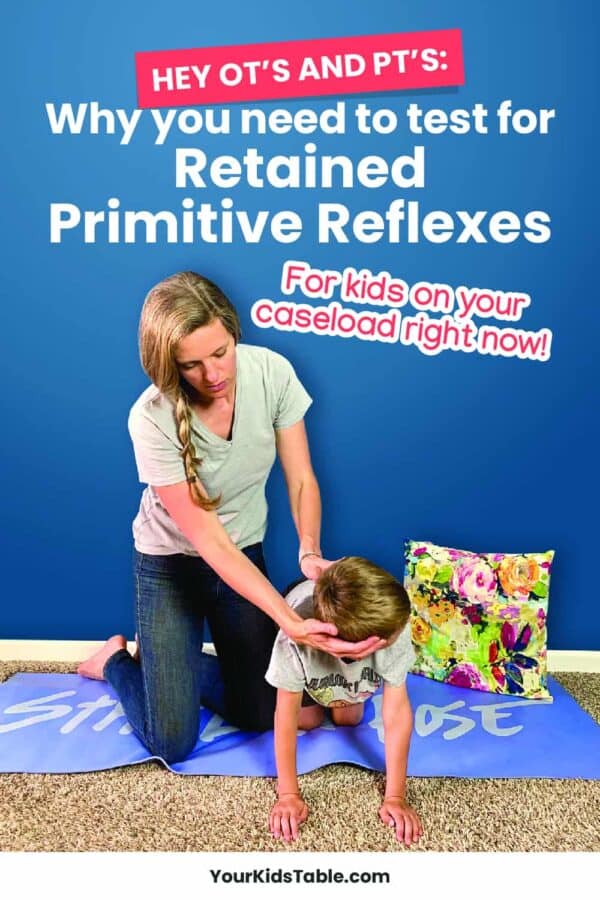Learn what retained primitive reflexes are, why we should test to see if kids have them, and how to help them integrate these reflexes so they don’t interfere with development. A must-read for pediatric occupational and physical therapists.
Today, I’m talking to my fellow occupational therapists and physical therapists out there working with kids in any capacity. Whether you treat at a school, early intervention, hospital, clinic, or out-patient setting, this is a must-read.
In 2004, I graduated from OT school and went to work for an amazing private practice in Washington D.C. The owner, Lynn Isreal, actually had studied under Jean Ayres. Working for her was a dream.
As a new therapist, I was well supported and taught advanced sensory integration techniques. But, one particular area that I learned could have a big affect on kids with sensory needs and learning difficulties was retained primitive reflexes.
To be perfectly honest, as a first year OT, it was a little over my head.
But, I held onto the knowledge that primitive reflexes may play a role in sensory processing difficulties.
It wasn’t until I did my own research and took a continuing education course on retained primitive reflexes and exercises to treat them that I realized how crucial it is that as pediatric OT’s and PT’s, we test for retention when signs are present.
What Does the Research Say About Retained Primitive Reflexes?
Before we even get started, I want to address the elephant in the room, for the evidence loving therapist. I see you and appreciate your diligence.
However, as with so many areas of occupational therapy, we need more research in this area. The research we do have does indicate that retention is present in some kids, particularly with ADHD and Autism. And, there’s some evidence to support integration as well.
See the list of references for specific studies at the end of the article, and if you have any you’d like to add, please leave them in the comments! We will continue to update this post as more research becomes available.

What Are Retained Primitive Reflexes and How Do They Affect Kids?
A lot of OT’s and PT’s have a loose understanding of what retained primitive reflexes are.
Most of us did learn about primitive reflexes in school. You remember the ATNR, TLR, Palmer, Moro, Landau, and others? Each of those are reflexes that are present in utero. They each serve a function in the birthing process and/or a child’s development. Helping them to eat, roll over, and crawl, for example.
Well, each of these reflexes should disappear or integrate at a specific time, so that higher level cognition can take place.
For some kids, they don’t integrate. The reflexes linger, often partially, and wreak havoc on all sorts of areas of development including sensory processing and even physical ailments.
When the brain holds on to the reflex, it’s as if it creates a block because it keeps triggering the involuntary movements from a reflex that shouldn’t be there anymore.
I sort of think of it like a record skipping. The brain is trying to read a paragraph, but the reflex fires unbeknownst to the child, just like a scratch on a record, and they can’t keep reading. They lose their place, they go back and try again, never making it forward. Just like the record can’t move on with the rest of the song.
The problem is that the retention of these reflexes isn’t super obvious.
Unless you know how to test for the reflexes, they’ll likely go un-noticed. Some kids have spent years in therapy struggling to make progress and fight their way through the traditional school system, only to finally work on integrating primitive reflexes and have their troubles seemingly melt away.
Head to our post on Reflex Integration Therapy to learn more about what each reflex is and what age it should disappear.
Why You Should Consider Assessing for Retained Primitive Reflexes
Why is testing for retention so important? Because, they’re literally the cause of all sorts of difficulties and delays that the kids we treat have. And, this retention could be the underlying cause.
My guess is that, as a therapist, you’re as obsessed with actually treating the root of the problem, like I am.
Of course, retained primitive reflexes aren’t always to blame, but we don’t know until we rule them out. Through exercises and specific movement patterns, the brain can finally integrate the reflex like it was supposed to.
That, of course, means that the behaviors, challenges, and delays a child was having because of the reflex are now gone:
- Kids that couldn’t cross midline because of a retained primitive reflex now can with relatively ease
- Kids that were wild, wiggly, and overly sensitive because of a retained primitive reflex now seem calm and regulated
- Kids with poor posture because of a retained primitive reflex no longer try to W sit or slouch all over their desk.
As a therapist of 17 years, I’m crazy excited about the implications for this, yet also wonder how many kids I personally missed this retention on because I wasn’t clearly taught why it was important, let alone how to assess for, or treat it years ago.
Fortunately, many of the therapeutic activities we do with kids in treatment are slowly helping to integrate reflexes, but without the intention and consistency of specific movement patterns, the reflexes may never get fully retained.
Which means some adults are walking around with retained reflexes. They’ve likely learned to make adaptations for and live with the results of reflexes that should have disappeared decades ago.
Of course, adults can still benefit from the same integration exercises.
(That’s why I just added a brand new bonus to my RISE with Sensory program that teaches students how to test for primitive reflexes. And, what exercises they can do if a child has retained one or more reflexes.)
How Do You Assess for Primitive Reflexes?
Before you assess any primitive reflexes, you’ll want to consider the risk factors for each of the reflexes. If a child has several (or a lot) of the signs that a reflex is present, then you’ll want to test for it.
You DO NOT need to test a child for every reflex, just the ones they could potentially have a connection to.
Here’s a list of common signs for some of the most popular reflexes that therapists may treat:
- Moro: car sickness, allergies, anxiety, mood swings, does not maintain eye contact
- TLR: poor posture, muscle weakness, poor balance, spatial problems, “W” sitting
- ATNR: eyes jump over words, right-left confusion, difficulty skipping, poor handwriting, difficulty riding a bike
- Spinal Gallant: bed wetting, poor concentration, poor memory, difficulty reading, slouching in chair
- STNR: messy eater, poor attention, floppy muscle tone, skipped crawling, difficulty swimming
- Rooting: chews on non-food objects often, loves crunchy foods, difficulty transitioning to solids, thumb sucking, speech problems
- Palmer: poor fine motor skills, difficulty with pincer grasp, poor handwriting, sticks out tongue while trying to draw, cut, etc., sensitive to textures on hands
Once you’ve narrowed down which reflexes a child has signs of retention, then you’ll want to test them. Each of the reflexes has a specific position to place the child in. Then, you guide or direct a movement and watch for any abnormal movements that shouldn’t be present.
For example, if you’re testing for the rooting reflex, you have the child sit down and relax. Then, you use your finger to stroke their cheek in several semicircles from their nose to their chin. While you do this, and immediately afterwards, you’re looking for involuntary movements of their cheek, mouth, or even their head turning.
Depending on how big the movement was, you’ll score the child with a 0 – 4. A zero indicates no movement at all while a 4 indicates significant movement.
If a child scores a 3 or 4, then specific movements and exercises will help integrate the reflex. If they score or 1 or 2, the reflex is almost totally integrated and unless the signs are disrupting a child’s life, no treatment for retention is needed.
Obviously, there are a lot of details and specific movements to look for. My example here were a quick overview. Each of the reflexes has a detailed testing procedure and scoring.
Inside my RISE with Sensory program, students get a bonus Primitive Reflexes Integration E-Book with detailed instructions and links to video demonstrations of the testing procedure and integration exercises. When you register for this sensory workshop you’ll get a discount on the program and some other freebies!
What is the Treatment for Retained Primitive Reflexes?
You’ve already heard me mentioning “exercises” for integrating primitive reflexes. The truth is there are a variety of approaches to integrating reflexes, but they all involve specific movement patterns.
Perhaps the most popular way to treat primitive reflexes is through daily exercises for 4 weeks. These exercises take just 5-10 minutes tops a day.
Kids will only work on 1-2 reflexes at a time and should complete them independently. Allow time for them to learn these activities.
An example of an integration exercise for the palmer reflex, for instance, is to isolate one finger at a time and touch the thumb. Holding a ball in the palm of the hand and squeezing the ball while a child isolates these movements is also helpful.
How You Can Use Primitive Reflex Exercises as Part of Your Treatment
You can complete the reflex integration exercises during your treatment time and let the parent know that you’ve done the exercises for the day. This will help give them a break as well.
It’s also beneficial to use the exercises in treatment because you can check in and make sure the child is completing the exercises correctly.
Of course, you’ll want to give the parents detailed instructions and demonstrations on how to complete these exercises at home on a daily basis. Consistency is key in helping these retained reflexes become integrated.
*All RISE with Sensory students have permission to print and reproduce the exercises to share with families on their caseload!*
How to Support Primitive Reflexes in the Classroom
If you work in a school, you can work with a teacher to help them incorporate integration exercises into their day. They only take a few minutes and the exercises are calming and organizing for all kids.
Teachers could have the whole class do the exercises as a brain break or as a quick station that they rotate through during centers.

Learn More in the RISE With Sensory Program (+ a free workshop)
RISE with Sensory is an AOTA approved CEU course for 6 hours. The entire program includes over 17 handouts that were designed for parents. You can print, copy, and duplicate these handouts for anyone on your caseload. Forever. As a special bonus to this course you’ll also receive the Primitive Reflex Integration E-Book.
Get a seat in our free sensory workshop, and you’ll be able to grab a 50$ off coupon to the program and if you attend and purchase live, 10 printable visual schedules (also can be shared with your caseload).
More Resources for Therapists
34 Oral Motor Exercises that You Never Knew You Needed
Learn Crossing Midline Activities to Improve Your Child’s Development!
Visual Perceptual Activities: 4 Ways to Boost Your Kids Development
Why Bilateral Integration is Critical for Kids and Activities to Improve It
Alisha Grogan is a licensed occupational therapist and founder of Your Kid’s Table. She has over 20 years experience with expertise in sensory processing and feeding development in babies, toddlers, and children. Alisha also has 3 boys of her own at home. Learn more about her here.
References
Primitive Reflexes: Screening, Compensation Techniques, and Treatment. Kim Wiggins OTR/L. (Sensational Brain 2021)
Burch, Sophia Grace, M. Feyen, A. Benson, A. Creger, A. J. Cash, Kyle Garcia, A. Boucher, H. Barrett and Lauren Dusek. “Reflex Based Interventions For Children with Autism and Developmental Disabilities: An Evidence-Based Practice Project.” (2016).
González, Sergio Ramírez, K. Ciuffreda, Luís Castillo Hernández and J. Escalante. “The Correlation between Primitive Reflexes and Saccadic Eye Movements in 5th Grade Children with Teacher-Reported Reading Problems.” (2008).
Gieysztor, E. Z., Choińska, A. M., & Paprocka-Borowicz, M. (2018). Persistence of primitive reflexes and associated motor problems in healthy preschool children. Archives of medical science : AMS, 14(1), 167–173. https://doi.org/10.5114/aoms.2016.60503
Edwards CW, Al Khalili Y. Moro Reflex. [Updated 2020 Aug 30]. In: StatPearls [Internet]. Treasure Island (FL): StatPearls Publishing; 2021 Jan-. Available from: https://www.ncbi.nlm.nih.gov/books/NBK542173/
Masgutova SK, Akhmatova NK, Sadowska L, Shackleford P, Akhmatov EA (2016) Neurosensorimotor Reflex Integration for Autism: a New Therapy Modality Paradigm. J Pediatr Neurol Disord 2: 107. doi:10.4172/2572-5203.1000107

My child is 21 and has issues with her primitive reflexes etc. Can an adult be helped?
Hi Tracy! Thanks for reaching out! Yes- adults can still benefit from the same integration exercises that can help with primitive reflexes!
Best,
Kalyn
Hi Alisha! Thanks for a great post. I’m a pediatric OT (staying at home with my 3 boys right now). My 6 year old definitely has many retained reflexes and sensory difficulties. There are so many reflex integration programs and courses out there (including yours), I’m just curious on your thoughts about MNRI and Rhythmic Movement? How do you choose the right program for your child? I try to do exercises with my child at home but I get so discouraged, as there seems to be so many distractions and barriers.
Thanks for your help!
Kimmy
Hey Kimmy,
Thanks so much for reaching out! Yes, we do have a sensory program, but as far as the retained reflexes it is a small piece and listed in the bonus section (not a main focus of the course), but is fully supported. We do help work through that in our private fb group! As for deciding which programs, I would reach out to everyone you are interested in possibly purchasing and ask if they do have a 30 day money back guarantee, so that if you do make a purchase and its not the right fit, you are able to get your money back and try something else! Hope that helps, let us know if you have any other questions!
Best,
Desiree
Is your assessing/integrating primitive reflex course appropriate for babies, specifically Birth-to-Three? I work in early intervention and would love to help kids before they enter the school system.
Hey Nicole,
Just to be clear the reflexes we added to our full RISE with Sensory course is an e-book – not a full course! However, it is linked to a variety of videos, etc to work your way through testing/treatment of the reflexes. What is provided is mostly geared for older children, however can be used on younger children (you will most likely need to manually complete the exercises for them – which may take longer to see progress). Hope that helps!
Best,
Desiree
Your Kids Table Team Member
What would you advice a parent who has a child that “w” sits? Is this something I should mention to his doctor.
Hey! “W” sitting isn’t ideal because of the position it puts the hips, pelvis and knees in and it doesn’t engage the tummy or core muscles, so it can weaken them over time. It would be worth mentioning it to your doctor if you have concerns!
Best,
Andrea
Hello,
If the child is showing many, but not all integrative primitive reflexes need work. Do you work on all or just the areas that are not integrated?
Hi there,
This is a great question. Ideally, you’ll want to start integrating them all one at a time, but many of the exercises build off one another and can begin integrating others as you go if that makes sense. Typically, I will start with the area that is most interfering to daily life and start there, moving to least. If that is unclear, you can pick a very clearly un-integrated reflex and just start there but usually one will stand out that is impacting daily life clearly. Does that help? Sonia Story and her resources at https://moveplaythrive.com/ are some of our favorite expert resources if you need more.
Best,
Laura
Your Kid’s Table team member
I am a newer OTR and am very interested in learning more about assessing and integrating primitive reflexes. I have not had success in finding a CEU that addresses this satisfactorily. Do you have any recommendations?
Hey Danielle,
One of the courses we did find helpful is listed in our resources in the article! It is based more for kids that are school aged!
Hope that helps!
Best,
Desiree
Your Kids Table Team Member
I would love to attend this conference but I can’t with the dates provided. Are you going to have any in August.
Hey Mary! You can go ahead and sign up, we send out a replay for the workshop the next day that you are able to watch when it’s convenient for you! If you would rather, you can always check back, we’re always adding new times 🙂
Best,
Andrea